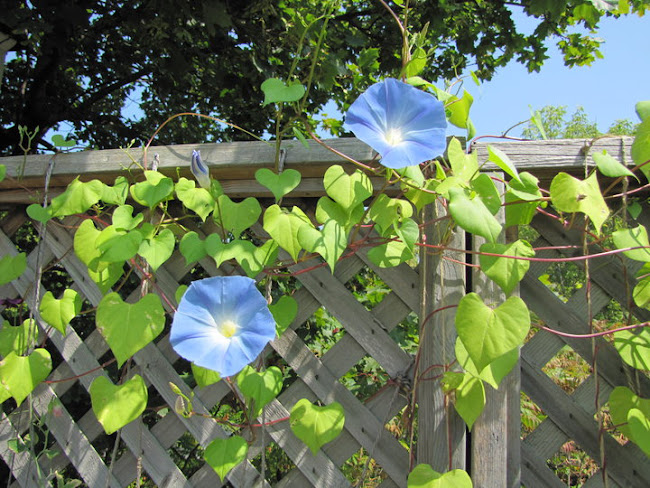
Zucchini Muffins
Brown sugar, nuts and raisins give these muffins a rich, complex flavour, completely disguising the zucchini.
1 1/2 cup flour
1/2 tsp baking powder
1/2 tsp baking soda
1/2 tsp salt
3/4 tsp cinnamon
1 cup firmly packed brown sugar
1 egg, beaten
1/2 cup vegetable oil
1 cup firmly packed grated zucchini
1/4 tsp vanilla
1/2 cup chopped walnuts or pecans
1/2 cup golden raisins
Preheat oven to 350F. Generously grease muffin tins or line them with muffin cups. Sift together flour, baking powder, baking soda, salt and cinnamon; then set aside. Combine brown sugar and egg and beat until light and fluffy. Add vegetable oil and beat mixture for 1-2 minutes. Add zucchini and vanilla and blend well. Stir in nuts and raisins. Quickly fold in dry ingredients until just evenly blended - do not overmix. Spoon batter into prepared muffin tins, filling them to the rim. Bake for 25 to 30 minutes, until lightly browned on top. Cool on a wire rack. Makes 1 Dozen Muffins.
Calabacita (Mexican Zucchini & Corn Sauté)
This dish is really versatile - you can add browned crumbled chorizo sausage or chopped jalapeños if you like things hot. I like to add 1/2 cup of chopped fresh cilantro and a squeeze of lime juice. Calabacita makes a good cold salad and a colourful stuffing for baked peppers, summer squash or tomatoes. Leftover Calabacita is great mixed with guacamole and served in soft flour or corn tortillas for a quick vegetarian lunch.
1 med onion, chopped
1 clove garlic, minced
1 tbsp butter
3 medium zucchini
2 cups corn kernels
2 plum tomatoes, chopped
1/2 tsp crumbled oregano
1/2 tsp salt, 1/4 tsp pepper
1/2 cup Queso Fresco or grated Monterey Jack cheese
Sauté onion and garlic in butter until tender. Add zucchini, corn, oregano, salt and pepper. Cook, covered, for 8 to 10 minutes until vegetables are almost tender. Uncover, increase heat slightly and cook 2 to 3 minutes more. Sprinkle with cheese and serve. Serves 6 as a side dish, 2 to 3 as a main course.
Chocolate Zucchini Cake.
This recipe comes courtesy of Caroline Bowden. It’s "extra delicious - somewhat nutritious!!!"
2 1/2 cup flour
1 tsp cinnamon
1 1/2 tsp. baking soda
2 cup sugar (or less, depending how sweet you like it)
2 tsp. vanilla
1/4 cup sour cream
1/2 cup cocoa
2 1/2 tsp baking powder
3/4 cup softened butter
3 eggs
2 cups shredded zucchini
1 cup chopped walnuts
1/2 cup chocolate chips
Preheat oven to 350F. Mix all ingredients together except for nuts and chocolate chips. Beat batter well, and then add nuts and chocolate chips. Pour into greased and floured bundt pan. Bake for 1 hour. Chocolate icing is recommended but optional :)
Zucchini with Lemony Crumbs
What element does Lemony Snicket say is not in the periodic table of elements? ... Bread crumbs!
2 pounds zucchini, coarsely grated
6 tbsp unsalted butter
1 1/2 cups coarse bread crumbs (from a day-old baguette)
1 1/2 tsp grated lemon zest
1 tsp crumbled, dried thyme or fresh chopped basil
2 garlic cloves, minced
Toss zucchini with 3/4 teaspoon salt in a colander set over a bowl and let it drain for 20 minutes. Squeeze handfuls of the grated zucchini in a kitchen towel to remove excess moisture. Melt 3 tbsp of the butter in a heavy 12-inch skillet over medium heat, then add bread crumbs, lemon zest, thyme, and 1/8 tsp salt. Stir frequently until the crumbs are golden, about 4 minutes. Transfer to a bowl and wipe out the skillet, then cook the finely chopped garlic in the remaining 3 tablespoons butter, over medium-high heat, stirring, until fragrant, about 30 seconds to one minute. Add zucchini and sauté until slightly softened, about 2 to 3 minutes. Serve the zucchini topped with bread crumbs. Makes 4 servings.
If you know any more amazing things to do with zucchini, feel free to post them in the comments section below.






































.JPG)






















